By Sheena Liang

For any international executive trying to do business in the United States, one of the main challenges is learning to navigate cultural differences between this country and his or her country of origin. They can be subtle sometimes but can have an enormous impact on multiple activities including hiring and managing employees, selling, negotiating contracts, and many others. In this article, we present one of the most widely used models for the understanding of cultural differences and use it to identify the most relevant ones when comparing the United States and several other countries. It has been improved over more than 50 years through extensive research.
The 6-D model, or Hofstede’s cultural dimensions theory – describes the relationship between culture, society, and individuals. This model was originally developed during the 1960s and 1970s, after Hofstede interviewed IBM employees scattered around the globe. Out of these initial surveys, Hofstede identified four dimensions to distinguish cultures: power distance, individualism vs. collectivism, masculinity vs. femininity, and uncertainty avoidance. Through independent research over the coming decades, Hofstede expanded his theories to include two additional dimensions: long-term vs. short-term orientation and indulgence vs. restraint. The model provides scales from 0 to 100 for 93 countries. Each country has a position on each scale or index, relative to other countries.
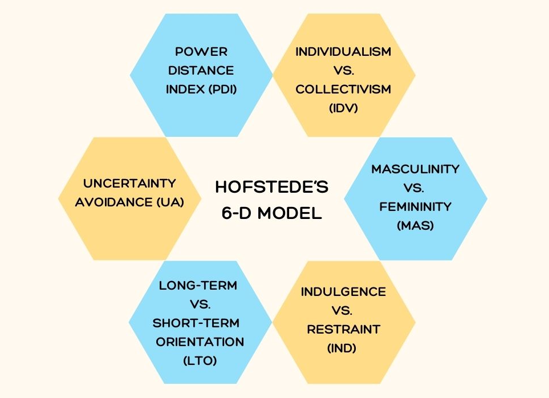
In the time of globalization, communications with people from other cultures are inevitable. If such encounters are not effectively handled, they might lead to misunderstandings or conflicts. This model is not only critical to reducing cultural barriers but is also applicable to international business management and negotiations. This article will introduce the 6-D model and will use it to analyze the business culture in the US. To help you gain a better idea of the different domains, this article has picked 5 other countries: Spain, Germany, India, China, and Mexico. We will compare their scores in each dimension with the rating assigned to the US and will explain what implications can be derived from the differences.
1. Power Distance Index (PDI)
The first dimension is the power distance index which is defined as “the extent to which the less powerful members of organizations and institutions accept and expect that power is distributed unequally”. In this dimension, inequality and power are perceived by the followers or the lower strata. A higher degree of the index indicates that hierarchy is clearly established and executed. A lower degree of the index signifies that people question authority and attempt to distribute power.
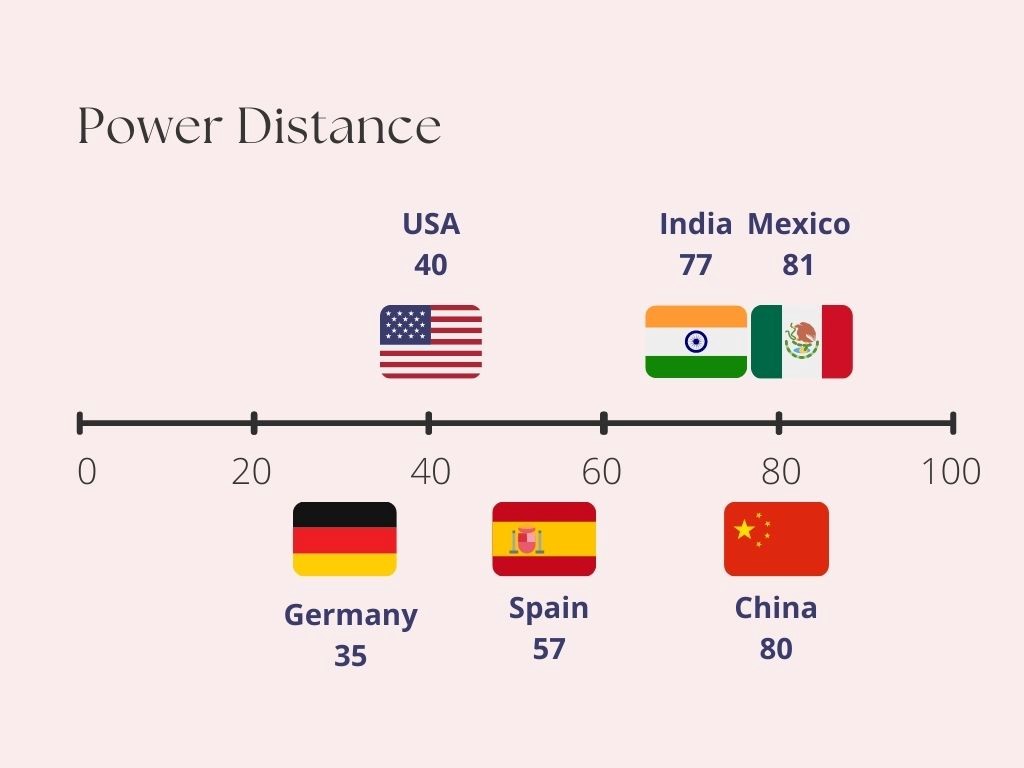
The United States and Germany scored 40 and 35 in this index which are relatively low when compared to Spain (57), India (77), Mexico (81), and China (80). In high power distance cultural settings, managers tend to express their authority and give instructions to other officers. Thus, employees will often equate age with intelligence and seniority. In contrast, in the US, people do not expect major power differences.
Within American organizations, hierarchy is established for convenience, superiors are accessible and managers rely on individual employees and teams for their expertise. Both managers and employees expect to be consulted and information is shared frequently. Thus, doing business with a US partner requires your company to maintain transparency and efficient communication at all levels. You should also make sure to not establish a sense of authority in front of clients which will make you seem less approachable.
2. Individualism vs. Collectivism (IDV)
The second dimension describes how cohesively people are integrated into groups. Individualistic societies place a greater emphasis on the individual and close family, while collectivist societies focus more on extended families and large groups.
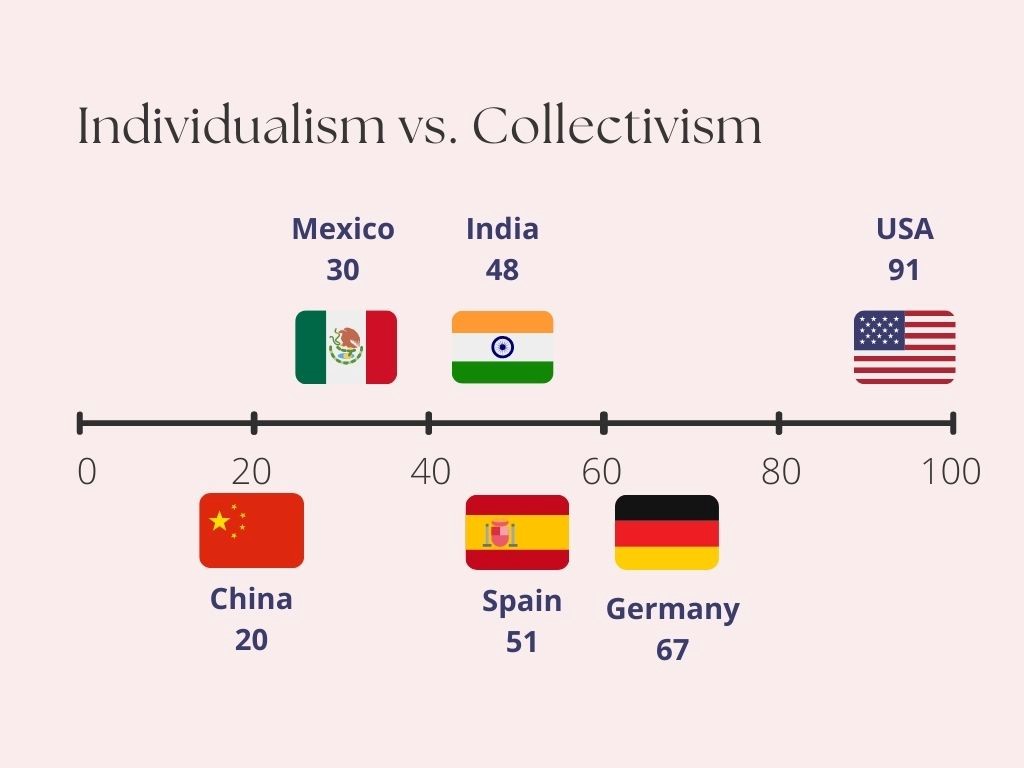
The US scored 91 and is considered one of the most individualistic countries in the world. Emerging countries like China and Mexico embody more collectivism while India, Spain, and Germany are in the middle range. In a highly individualistic country like the US, people are expected to take care of themselves and their immediate family only. Employees are valued primarily on the basis of individual success. Moreover, people put more importance on privacy protection and freedom of speech. It is critical that your business respect people’s privacy according to local laws and regulations. When negotiating with companies in the US, it is important to listen to all of the representatives’ opinions and try to persuade more people as personal opinion is expected and each person will usually get one vote.
3. Uncertainty Avoidance (UA)
The third dimension outlines how much people tolerate ambiguity or uncertain situations. A high UA score indicates that the country is governed by clear norms and laws that are made clear to everybody. As a result, such a country will not accept any ambiguous circumstance or unclear or unknown issue. In contrast, societies with low uncertainty avoidance are comfortable with risk, change, and unpredictability. In these countries, risky and ambiguous situations are less likely to upset people.
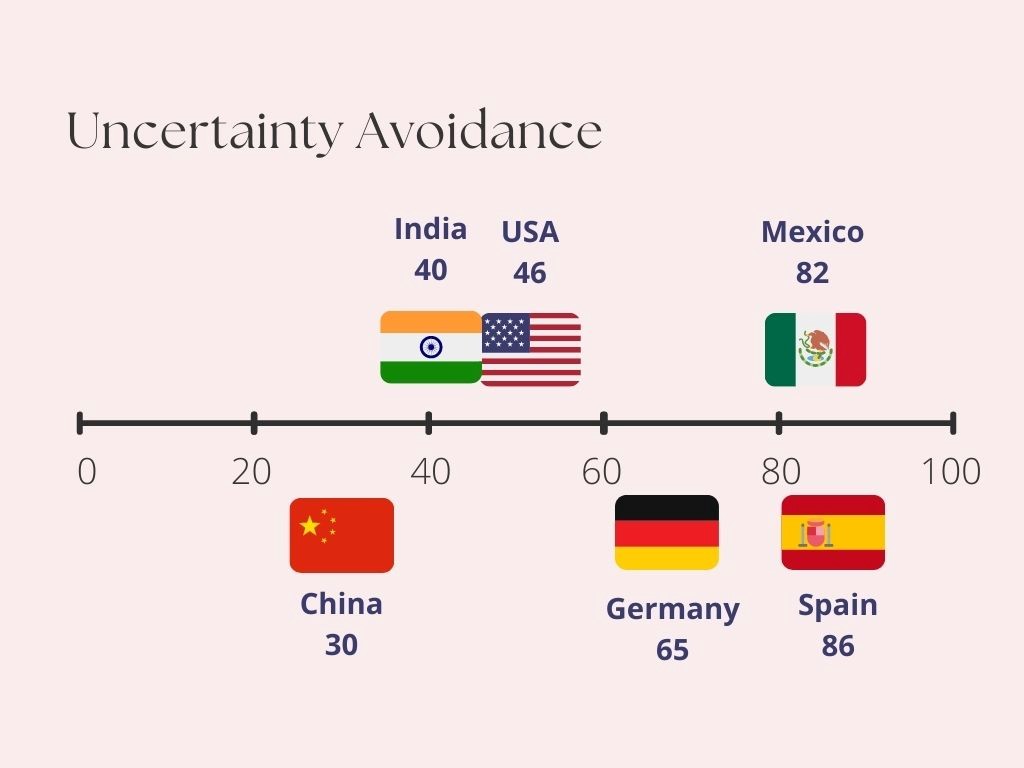
Spain, Mexico, and Germany have high scores in this index which means that they have low tolerance for uncertainties. These countries are governed by clear norms and laws that are made clear to everybody. As a result, work environments in such countries should try to provide stability and certainty through clear rules and instructions. The US, India, and China have relatively lower uncertainty avoidance scores with scores of 46, 40, and 30, respectively. The US society has a high tolerance for different persons and ideas. People are curious about diversity and new things. Thus, you usually do not have to worry about being a foreign company. Although you will face many regulation barriers, local companies are willing to collaborate if they can bring new ideas to the table. One other thing to notice is that it is common for employees in the US to change jobs often instead of staying in one place. People prefer personal development and benefits over stability. Thus, if your company plans to hire local employees, you should have an employee benefits package that attracts but also retains the best talent, and be ready for a high turnover.
4. Masculinity vs. Femininity (MAS)
The fourth dimension looks at the extent to which gender differences affect the distribution and control of power and wealth among citizens of a country. Speaking more broadly, a masculine society indicates that the society will be driven by competition, achievement, and success, with success being defined by the “winner” or “best-in-the-field”. A feminine society means that the dominant values are caring for others and quality of life.
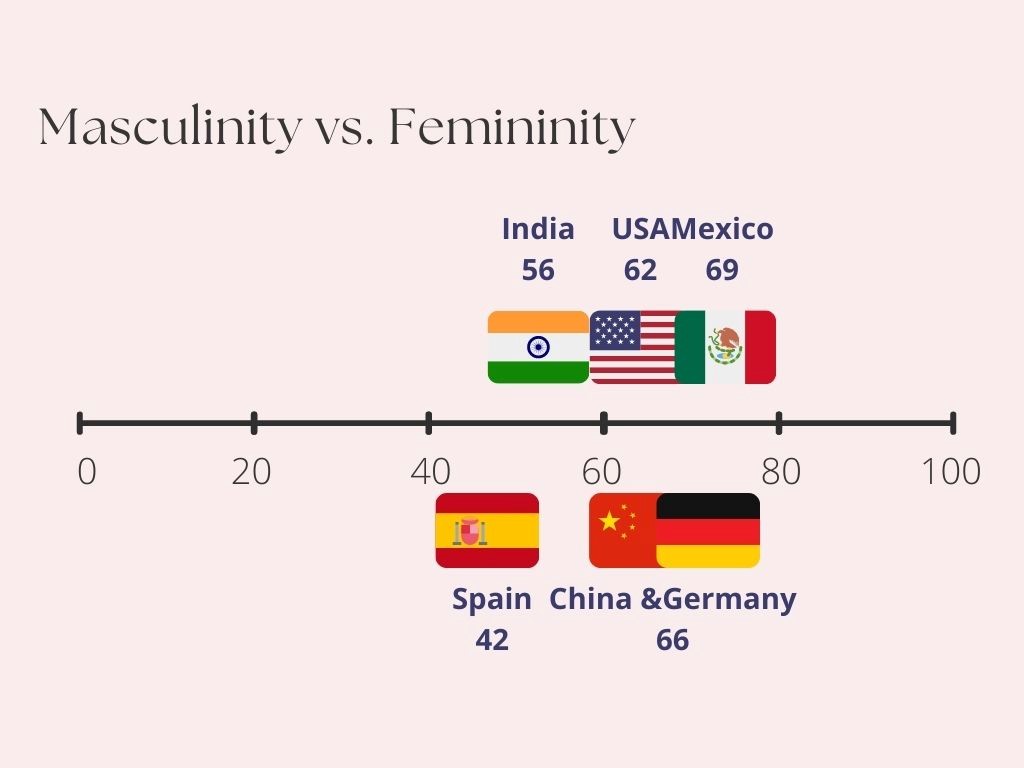
According to the graph, 5 of the 6 countries have scores above 50, while Spain scores 42 in this index. The US scored 62 which suggested having moderately high masculinity, while Spain is more feminine. In the workplace, employees in Spain will prefer to balance work and life. In contrast, US employees prefer higher pay and are willing to accept less vacation. Thus, it is important to evaluate how your company should incentivize employees. Moreover, in the US there is an admiration for strength and toughness. Companies usually like to obtain many certifications or be positioned high in a certain ranking to showcase their uniqueness over others. Thus, if your company has any awards or recognitions from authorized sources, you should highlight them on its website. When introducing your company to US investors, you should also emphasize results and accomplishments instead of focusing on the company’s history.
5. Long-Term Orientation vs. Short-Term Orientation (LTO)
The fifth dimension associates the connection of the past with the current and future actions/challenges. A lower degree of this index (short-term) indicates that traditions are honored and kept, while steadfastness is valued. Societies with a high degree in this index (long-term) view adaptation and circumstantial, pragmatic problem-solving as a necessity.
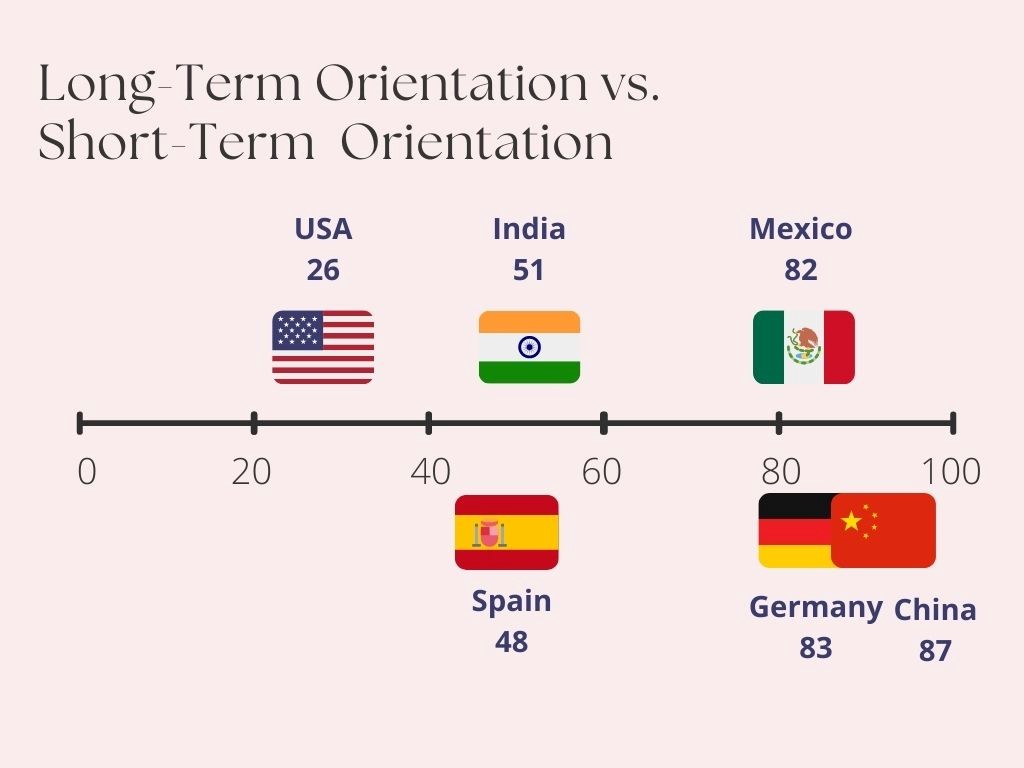
The United States has a low score of 26 which means it is short-term oriented. China (87), Germany (83), and Mexico (82) all have really high scores which indicate long-term orientation. They tend to learn from other countries and adapt their tradition. This result might differ from what most people perceive about the US as a long-term-oriented country because it is highly developed and has many innovations. However, this index considers the cultural aspect in general and has nothing to do with the economy. When you look at issues such as abortion, use of drugs, euthanasia, and weapons, the American culture seems very traditional and rooted. Americans are prone to analyze new information to check whether it is true. Thus, the culture does not make most Americans pragmatic, but this should not be confused with the fact that Americans are very practical. Most American businesses measure their performance on a short-term basis, with profit and loss statements being issued on a quarterly or even monthly basis. This also drives individuals to strive for quick results within the workplace.
6. Indulgence vs. Restraint (IND)
The sixth and last dimension refers to the degree of freedom that societal norms give to citizens in fulfilling their human desires. Indulgence is defined as “a society that allows relatively free gratification of basic and natural human desires related to enjoying life and having fun”. Its counterpart is defined as “a society that controls gratification of needs and regulates it by means of strict social norms”.

China, India, Germany, and Spain all have relatively low scores in this index which indicates that they are more restrained. The United States is an indulgent society with a score of 68. Mexico scores the highest among the six chosen countries and can be considered highly indulgent. In an indulgent society like the US, employees are likely to value both personal and professional success equally. Americans always want to reward themselves for the hard work they do which reflects the popular phrase “work hard, play hard”. American workers like to go to happy hours or different kinds of networking events to interact with professionals in a less formal way. American companies often have different interest groups or sports teams to create a positive work environment. American employees strive for the reward and benefit for the hard work they have accomplished. In contrast, restrained countries put less emphasis on leisure and have a more clear separation between work and family.
CONCLUSIONS
The 6-D model developed by Geert Hofstede introduces the basis of cultural differences in values and beliefs regarding work goals. This effort resulted in the six main dimensions that we have introduced above: power distance, individualism versus collectivism, masculinity versus femininity, uncertainty avoidance, long-term orientation versus short-term normative orientation, and indulgence versus restraint.
Every country is different. Some countries might have similar and even the same score for one dimension but have completely different scores for others. This model can be very useful for international companies doing business in the United States to help in understanding customer behavior, managing employees, preparing for successful negotiations, and many other situations.
Additional information about the model can be found in the article “Dimensionalizing Cultures: The Hofstede Model in Context” by Geert Hofstede, published in ScholarWorks@GVSU, Online Readings in Psychology and Culture. Comparisons using the model for many countries can be easily made using Hofstede’s Country Comparison Tool.
Markentry USA has a wide network of multicultural collaborators who can help international companies define the best strategy to enter the US market and navigate the challenging cultural differences they will encounter.
Share this:
- Click to share on LinkedIn (Opens in new window) LinkedIn
- Click to share on Facebook (Opens in new window) Facebook
- Click to share on X (Opens in new window) X
- Click to share on Pinterest (Opens in new window) Pinterest
- Click to share on Telegram (Opens in new window) Telegram
- Click to print (Opens in new window) Print
- Click to share on WhatsApp (Opens in new window) WhatsApp
